Portal:Buses/Selected article
Selected article 1
Portal:Buses/Selected article/1
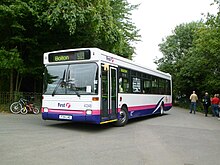
The Dennis Dart is a rear-engined single-decker midibus chassis that was introduced by Dennis of Guildford, England, in 1989, replacing the Dennis Domino. Initially built as a high-floor design, in 1996 the low-floor second generation Dennis Dart SLF was launched. In 2001, production of the Dart SLF passed to TransBus International, during which time it was sold as the TransBus Dart SLF; Alexander Dennis took over production in 2004, renaming the product as the Alexander Dennis Dart SLF.
More than 12,600 Darts were produced in total during a 19-year production run. Most were purchased by United Kingdom operators, although examples were sold in Europe, North America, Australia and Hong Kong. In the United States, the Dart SLF, with Alexander ALX200 bodywork, was built and sold by Thomas Built Buses as the Thomas SLF 200.
The first generation Dart ceased production in 1998. Production of the Dart SLF continued until 2008, when it was replaced by the Alexander Dennis Enviro200. (
Full Article)
Selected article 2
Portal:Buses/Selected article/2
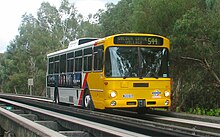
The O-Bahn Busway is a guided busway that is part of the bus rapid transit system servicing the northeastern suburbs of Adelaide, South Australia. The O-Bahn system was conceived by Daimler-Benz to enable buses to avoid traffic congestion by sharing tram tunnels in the German city of Essen.
Adelaide's O-Bahn was introduced in 1986 to service the city's rapidly expanding north-eastern suburbs, replacing an earlier plan for a tramway extension. The O-Bahn provides specially built track, combining elements of both bus and rail systems. The track is 12 kilometres (7.5 mi) long and includes three interchanges at Klemzig, Paradise and Tea Tree Plaza. Interchanges allow buses to enter and exit the busway and to continue on suburban routes, avoiding the need for passengers to transfer to another bus to continue their journey. Buses can travel at a maximum speed of 100 km/h (60 mph), but are restricted to 90 km/h (55 mph). As of 2015[update], the busway carried approximately 31,000 people per weekday. An additional section including a 670-metre (2,200 ft) tunnel opened in 2017 at the city end to reduce the number of congested intersections buses must traverse to enter the Adelaide city centre.
The development of the O-Bahn busway led to the development of the Torrens Linear Park from a run-down urban drain into an attractive public open space. It has also triggered urban development around the north-eastern terminus at Modbury. (
Full Article)
Selected article 3
Portal:Buses/Selected article/3
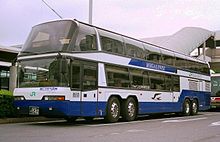
JR Bus collectively refers to the bus operations of Japan Railways Group (JR Group) companies in Japan. JR Bus is operated by eight regional companies, each owned by a JR railway company. JR Bus companies provide regional, long distance, and chartered bus services. (
Full Article)
Selected article 4
Portal:Buses/Selected article/4
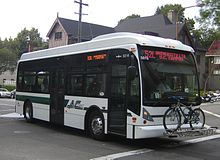
A destination sign (North American English) or destination indicator/destination blind (British English) is a sign mounted on the front, side or rear of a public transport vehicle, such as a bus, tram/streetcar or light rail vehicle, that displays the vehicle's route number and destination, or the route's number and name on transit systems using route names. The main such sign, mounted on the front of the vehicle, usually located above (or at the top of) the windshield, is often called the headsign, most likely from the fact that these signs are located on the front, or head, end of the vehicle. Depending on the type of the sign, it might also display intermediate points on the current route, or a road that comprises a significant amount of the route, especially if the route is particularly long and its final terminus by itself is not very helpful in determining where the vehicle is going. (
Full Article)
Selected article 5
Portal:Buses/Selected article/5

The Witch Way is the branding for long-standing English bus route X43, which runs between Burnley and Manchester. The service is currently operated by The Burnley Bus Company.
The route has operated continuously since 1948. It was previously operated by Ribble Motor Services, Stagecoach North West and Burnley & Pendle, while GM Buses briefly competed with Stagecoach on the route. During its history it has served several places no longer on the present route, including Bury and the Trafford Centre.
The service was rebranded as The Witch Way in 2005 to coincide with the introduction of new vehicles. It had previously been branded as The X43 and before then was unbranded. Between 1982 and 1986 the route was known as Timesaver, with buses carrying dedicated liveries. (
Full Article)
Selected article 6
Portal:Buses/Selected article/6
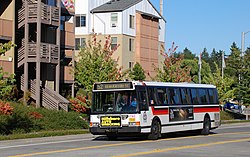
The Flxible Metro is a transit bus that was assembled and manufactured by the Flxible Corporation from 1983 until 1995. From 1978 until early-1983, when Flxible was owned by Grumman, the model was known as the Grumman 870, with a Grumman nameplate. The earlier model 870 experienced a large number of major design defects and deficiencies, some of which led to the filing of lawsuits against the company by purchasers, and the successor "Metro" model addressed those defective design issues.
Over the combined 17-year production history, a total of 14,456 were built, of which 4,642 were model 870 and 9,814 were Metros. (
Full Article)
Selected article 7
Portal:Buses/Selected article/7
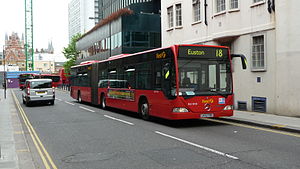
An articulated bus, also referred to as a slinky bus, bendy bus, tandem bus, vestibule bus, stretch bus, or an accordion bus, is an articulated vehicle, typically a motor bus or trolleybus, used in public transportation. It is usually a single-decker, and comprises two or more rigid sections linked by a pivoting joint (articulation) enclosed by protective bellows inside and outside and a cover plate on the floor. This allows a longer legal length than rigid-bodied buses, and hence a higher passenger capacity (94–120), while still allowing the bus to maneuver adequately.
Due to their high passenger capacity, articulated buses are often used as part of bus rapid transit schemes, and can include mechanical guidance. Articulated buses are typically 18 m (59 ft) long, in contrast to standard rigid buses at 11 to 14 m (36 to 46 ft) long. The common arrangement of an articulated bus is to have a forward section with two axles leading a rear section with a single axle, with the driving axle mounted on either the front or the rear section. Some articulated buses have a steering arrangement on the rearmost axle which turns slightly in opposition to the front steering axle, allowing the vehicle to negotiate tighter turns, similar to hook-and-ladder fire trucks operating in city environments. A less common variant of the articulated bus is the bi-articulated bus, where the vehicle has two trailer sections rather than one. Such vehicles have a capacity of around 200 people, and a length of about 25 m (82 ft); as such, they are used almost exclusively on high-capacity, high-frequency arterial routes and on bus rapid transit services. (
Full Article)
Selected article 8
Portal:Buses/Selected article/8
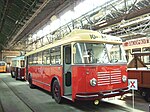
A gyrobus is an electric bus that uses flywheel energy storage, not overhead wires like a trolleybus. The name comes from the Greek language term for flywheel, gyros.
While there are no gyrobuses currently in use commercially, development in this area continues. (
Full Article)
Selected article 9
Portal:Buses/Selected article/9
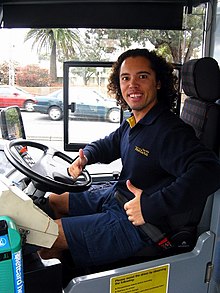
A bus driver, bus operator, or bus captain is a person who drives buses for a living. (
Full Article)
Selected article 10
Portal:Buses/Selected article/10
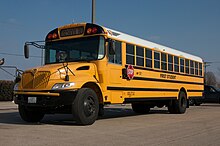
A school bus is any type of bus owned, leased, contracted to, or operated by a school or school district. It is regularly used to transport students to and from school or school-related activities, but not including a charter bus or transit bus. Various configurations of school buses are used worldwide; the most iconic examples are the yellow school buses of the United States which are also found in other parts of the world.
In North America, school buses are purpose-built vehicles distinguished from other types of buses by design characteristics mandated by federal and state/provincial regulations. In addition to their distinct paint color (National School Bus Glossy Yellow), school buses are fitted with exterior warning lights (to give them traffic priority) and multiple safety devices. (
Full Article)
Selected article 11
Portal:Buses/Selected article/11
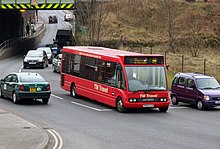
Full Article)
Selected article 12
Portal:Buses/Selected article/12
Aerocoach (full name General American Aerocoach Corporation) was a bus and coach manufacturer based in Chicago, Illinois, in the United States and was popular in the 1940s. The company existed between 1939 and 1952 when it went out of business. Its first manager was Harry Alphonse Fitzjohn, co-founder of the FitzJohn-Erwin Manufacturing Company. (
Full Article)
Selected article 13
Portal:Buses/Selected article/13
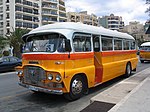
Buses were introduced to Malta in 1905. As well as providing public transport across the country, up until 2011, the traditional Malta bus (Maltese: xarabank or karozza tal-linja) served as a popular tourist attraction due to their unique appearances grounded in the bus ownership and operation model employed in the country; by the end of this traditional operation, Malta had several bus types no longer in service anywhere else in the world.
The unique nature of the Malta bus stemmed from the tradition of local ownership of the buses by the drivers, and their historic practice of customising them. In addition to a high degree of customisation, detailing and decoration, several Malta buses also had a unique appearance due to the practice of in-house maintenance, rebuilding or modifying of bus bodies in local workshops.
As an iconic feature of the country, the classic Malta bus features on several tourist-related items. As the main mode of public transport across the country, the Malta bus was also used by many tourists to visit the different parts of the country. While newer Malta buses were progressively introduced that followed modern standard bus designs found elsewhere, customisation and detailing had continued for these buses as well.
On 3 July 2011, the network of service bus routes across Malta was taken over by Arriva, with traditional buses reduced to operating on only special heritage services.
Arriva introduced a fleet of modern low-floor buses, importing secondhand ex-London articulated Mercedes-Benz Citaros, retaining and repainting some of the 'newest' buses from the old fleet in Arriva colours as well as purchasing a fleet of brand new King Long rigid buses. Arriva's operation in Malta was beset by problems; three fires within a 48-hour period in August 2013 prompted the Maltese government to ban the articulated Citaros from operation in the country pending an investigation.
Arriva operation in Malta continued until 1 January 2014, when the nation's bus network was nationalised as Malta Public Transport. On 8 January 2015, Malta Public Transport was reprivatised as it was sold to Autobuses Urbanos de León (an Alsa subsidiary), who retained the Malta Public Transport brand name. The company doubled the bus fleet, which now consists of more than 400 buses.
Malta Public Transport has invested extensively in modernizing its bus fleet making it safer, more environmentally friendly, and more comfortable. The company invested in 200 new buses with the latest Euro VI diesel technology. The buses are cleaned and maintained regularly, and are equipped with air-conditioning systems for added comfort. All the new buses have two doors to facilitate boarding and alighting of passengers. (
Full Article)
Selected article 14
Portal:Buses/Selected article/14
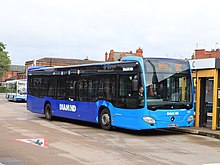
The Mercedes-Benz Citaro is a single-decker, rigid or articulated bus manufactured by Mercedes-Benz/EvoBus. Introduced in 1997, the Citaro is available in a range of configurations, and is in widespread use throughout Europe and parts of Asia, with more than 55,000 produced by December 2019. (
Full Article)
